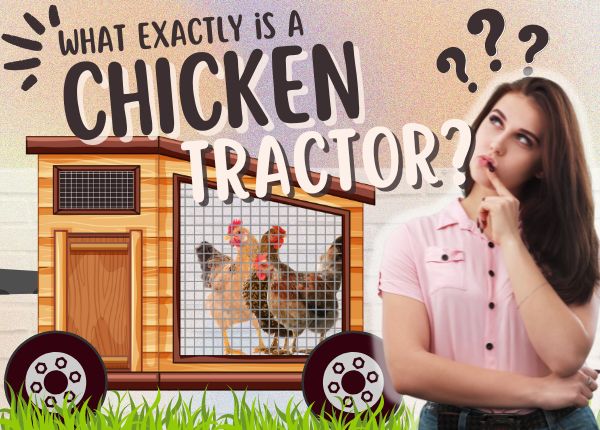
Modern strains of farming roosters can be spotted in certain parts of the US wearing checked shirts and driving teeny tiny little tractors. I’m joking! That would be very cool, but it’s not what chicken tractors are all about.
Chicken tractors are chicken runs on wheels. They’re mobile homes for your Marans, or Winnebagos for your Wyandottes.
Chicken tractors let you and your chickens benefit from all of the perks of free-ranging as well as the security of an enclosed run. It’s like having your chicken-keeper cake and eating it!
A chicken tractor doesn’t have to have wheels, but it makes life a lot easier if they do! What they do need to have to qualify as a mobile hen home, is the capacity to be moved about freely, and no base. The idea is that your chickens have access to forage on fresh ground regularly, whilst staying safe and enclosed.
If you have a decent amount of land but you’re anxious about allowing your chickens to roam free or aren’t allowed to because of county rules, then the chicken tractor is the real estate you need for your egg troop.
Just like other chicken coops and runs, chicken tractors come in all shapes and sizes, and they can be homemade or purchased at the store. The design options are endless.
What I love about my chicken tractor is that it takes my chicken-keeping mission one step closer to a sustainable lifestyle. The grass and grubs go in, the poop and eggs come out, and the natural nutrient cycle is complete.
Chicken tractors offer a simple yet superb, symbiotic, and sustainable solution to keeping chickens.
Don’t tie yourself down to a coop before you’ve done your real-estate research on chicken tractors.
Above all else, you need to keep your feathery friends safe. You can treat them to a poultry palace but if it doesn’t keep them safe then it’s pointless. Avoid the heartache and put safety first with Chickenpedia’s Chicken Coops Crash Course which covers the ideal size, material & design of hen home to suit your flock (and YOU!)
Please egg-scuse my inner comedi-hen here. I can never resist a cheeky chicken pun, Chicken tractors are wheely rather good!
If any of this chicken-tractor info tickles your fancy, then read on:
What are Chicken Tractors?
Why Are They Called Chicken Tractors?
What’s The Point of Chicken Tractors?
Is A Chicken Tractor Just a Run?
Do I Still Need a Coop?
The Pros & Cons
Chicken Tractors Vs Standard Coops
Chicken Tractors Vs Free Range Chickens
How Often Do You Have to Move Chicken Tractors?
Can Chicken Tractors Be Used in The Winter?
Can Chickens Dig Out of Chicken Tractors?
Are Chicken Tractors Safe?
How Big Should a Chicken Tractor Be?
How Tall Should Chicken Tractors Be?
Are Chicken Tractors Suitable for Laying Hens?
How Do You Move a Chicken Tractor Without the Chickens Escaping?
Are Chicken Tractors Expensive?
Are Chicken Tractors Easy to Build?
What Are Chicken Tractors?
A chicken tractor is a chicken run that can be moved around your land regularly and doesn’t have a permanent floor. They usually have wheels – which is better for your back - but they can just be dragged about. It’s the mobile, floor-free design that qualifies a run as a chicken tractor.
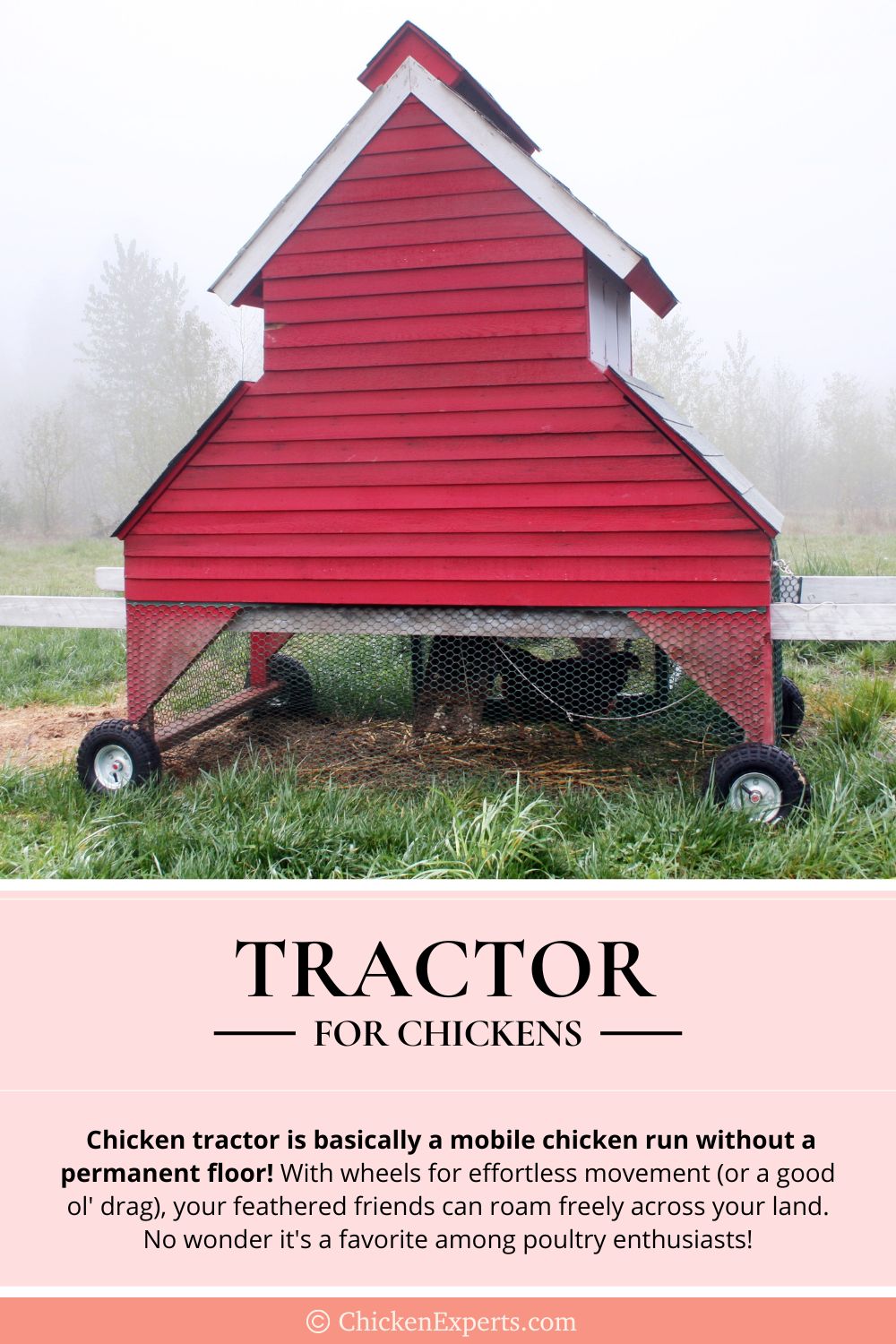
Why Are They Called Chicken Tractors?
Chicken tractors get their name from the groundwork function that they perform. Just like a traditional tractor preparing topsoil to sow seeds, the bottomless design allows chickens to peck and scratch (or till) the ground section by section. Plus, they fertilise it as they go.
What’s The Point of a Chicken Tractor?
Chicken tractors are great for allowing chickens access to fresh vegetation and bugs, which is the perfect poultry diet. It also encourages exercise and offers natural mental stimulation.
Moving position means they can do this without depleting their food source. Any chicken keeper will tell you that it doesn’t take these ladies long to turn a luscious lawn into a muddy mess if they’re kept in one place.
Sure, letting your ladies roam free offers them the perfect pickings from Mother Nature’s pantry, but it’s not allowed everywhere, and it comes at a risk.
Free-range chickens can fly off, get lost, annoy the neighbors, destroy your flower beds, and polish off your herb garden all in one day. You’ll also be hunting through the hedgerows for weeks for their elusive eggs.
Chicken tractors allow your chickens and your land to benefit from a more natural nutrient cycle, which reduces feed costs and eliminates the risks and damage associated with roaming free. There’s no coop floor to muck out – which to me was a big plus point – and there’s no need to purchase litter for the run floor.
The main plus point to chicken tractors, in my humble opinion, is that free-range chickens are at much greater risk from every type of predator.
Is A Chicken Tractor Just a Run?
Chicken tractors usually combine a coop complete with roost bars and nest boxes, and a run. These roaming hotels can offer everything your chickens need, all in one place…but a place that moves.
Do I Still Need a Coop If I Buy a Chicken Tractor?
Some owners prefer to use a chicken tractor as a mobile run in the day and transfer their flock into a more solid, static coop at night. This is often the preferred route for keepers who are concerned about the weather conditions or predation from ground-based predators like coyotes or raccoons. 🦝
Exercise-only chicken tractors can be more lightweight and simpler in design, but they still need to offer security and protection from the elements come rain or shine.
Chicken Tractors Vs Standard Coops
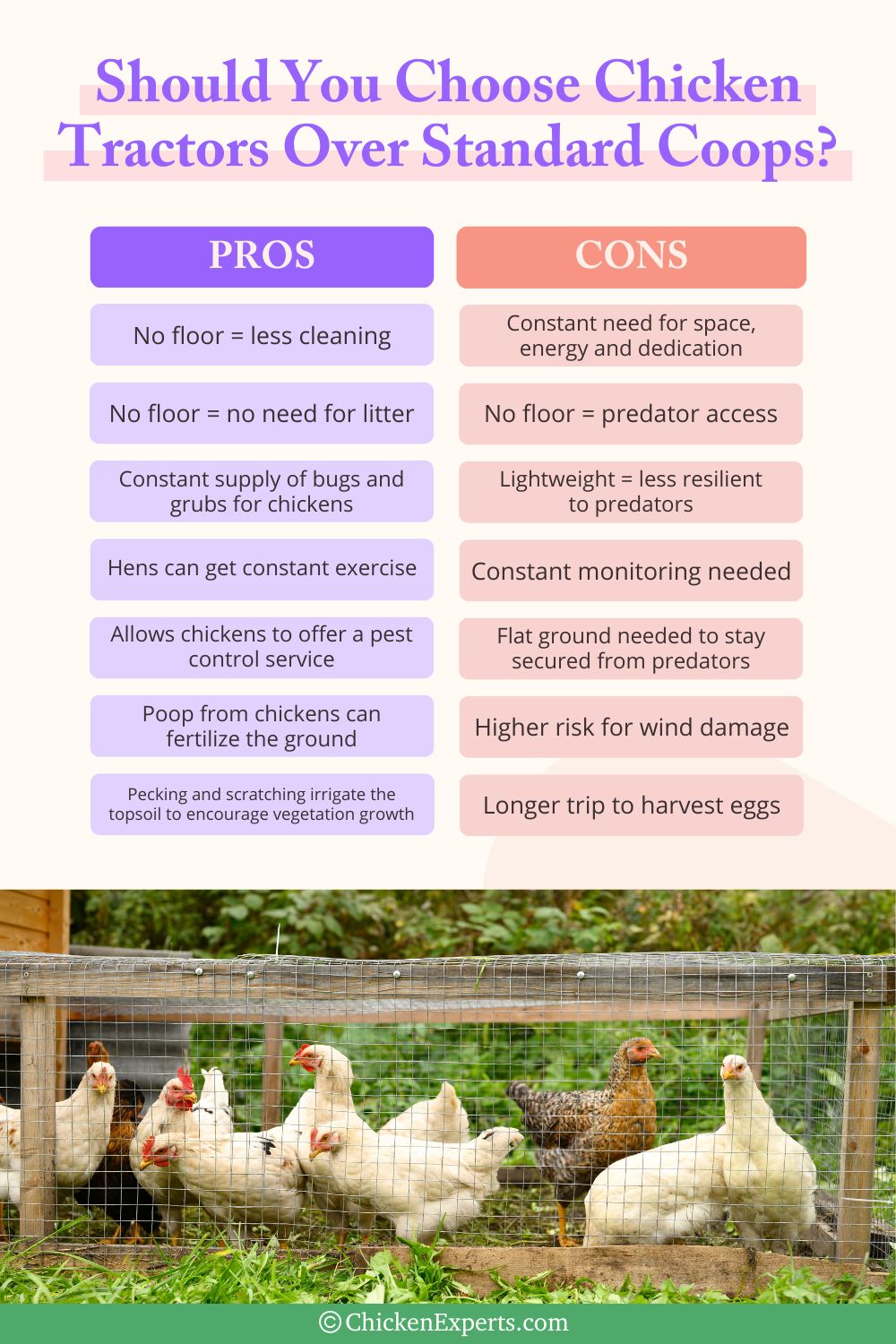
Are chicken tractors better than static runs? If you have the land, then my vote is yes! Here are some pros and cons of choosing a mobile chicken home.
7 PROS:
- There’s no floor – so there’s less cleaning
- There’s no floor – so you needn’t spend on any litter to line your run with
- Chickens get a constant supply of fresh vegetation, bugs, and grubs
- Stimulation, exercise, and variety makes for happy hens
- Allows chickens to offer a pest control service
- Your mobile poop troop will fertilize the ground nicely
- Pecking and scratching irrigate the topsoil to encourage vegetation growth
7 CONS:
- You need the space, the strength, and the dedication to move the tractor regularly
- Having no floor can make chickens more vulnerable to land predators
- Chicken tractors tend to be lightweight to enable movement, which can make them less resilient to large predators
- Ground conditions need to be monitored constantly
- You need flat ground or there will be holes for chickens to get out or predators to get in
- As they aren’t anchored, they’re at higher risk of wind damage
- Moving the coop around might mean a longer trip to harvest those yummy eggs in your dressing gown!
Chicken Tractors Vs Free Range Chickens

Is it better to keep chickens in a chicken tractor or allow them to free-range? If you have the land then why not let them loose? No two chicken families are the same, and there are pros and cons to using a chicken tractor over free-ranging:
7 PROS:
- Significantly reduced risk of aerial predation
- Less vulnerable to ground predators
- No risk of chickens escaping, getting lost, or causing trouble
- Within regulations for counties where free ranging is not allowed
- You have control over which vegetation your chickens feed on
- No need to clip wings or add high ugly, high boundary fences for flighty chicken breeds
- Easter egg hunts are just once a year!
7 CONS:
- Your girls can run up and greet you when you go to see them. Priceless!
- Free ranging doesn’t require a weekly shuffle
- Free ranging allows chickens to escape should a predator reach them
- Free ranging doesn’t require a flat surface
- There’s nothing more natural than freedom...let's be honest!
- Endless stimulation and exercise for healthy and happy chickens 🐔
- The chicken poop isn’t refined to one area either!
How Often Do You Have to Move Chicken Tractors?
You’ll need to reposition your chicken tractor twice a week. It could be needed more or less frequently depending on the number and nature of the chickens in your flock and on the quality of the ground. You should never let the ground run bare.
Some chickens will dig more than others, meaning you need to move your tractor more often to avoid bald patches in your lawn. Those dust baths can quickly look like craters if you don’t move Dolly and Dotty along!
Can Chicken Tractors Be Used in The Winter?
Chicken tractors can be used to house chickens all year round, but you’ll need to make sure the coop is warm enough in the winter❄️ and cool enough in the summer. Remember to anchor it down in high winds too!
The ground also must be dry, so you should never park up anywhere that’s at risk of flooding and the coop section should always be raised above ground level to avoid dampness. I’d plan in an area of solid ground where you can park the tractor and add a layer of litter if the ground is too wet. Don’t forget they’ll need extra feed if you must remove their carpet picnic.
Can Chickens Dig Out of Chicken Tractors?
Chickens do dig, but not skilfully enough to tunnel their way free from confinement. Chickens will scratch and dig to get that one blade of grass that’s just outside the run because they’re awkward like that, but they won’t be planning a tactical escape tunnel.
The main risk with digging under a chicken tractor is predators like foxes, raccoons, or opossums digging their way in, rather than your chickens digging out.
Are Chicken Tractors Safe?
Chicken tractors aren’t always thought of as being as secure as static runs, for obvious reasons. Although, a well-built tractor could be much safer than a flimsy, store-bought run.
You can also create a no-dig skirt around the outer edge of the tractor with wire or use tent pegs to secure the edges down.
How Big Should a Chicken Tractor Be?
The coop, nest boxes, and run area of a chicken tractor should be sized as you would any chicken accommodation.
Most chicken tractors are around 4 to 10 feet wide and 6 to 15 feet long, but the size of your flock and the chickens that you are keeping in it should dictate the size of the chicken tractor that you choose.
As a rule, each large fowl breed should have 4 square feet of coop space and 10 square feet of run. Bantam chickens will need less space and larger chicken breeds will need more.
Always go bigger where you can since larger tractors allow for your flock to grow and your chickens to flourish, and you won’t have to move them as much!
“Overcrowding can cause your pets to stress out and peck each other or themselves, which makes them more vulnerable to injury and disease.” (Chickenpedia’s Chicken Coop Crash Course)
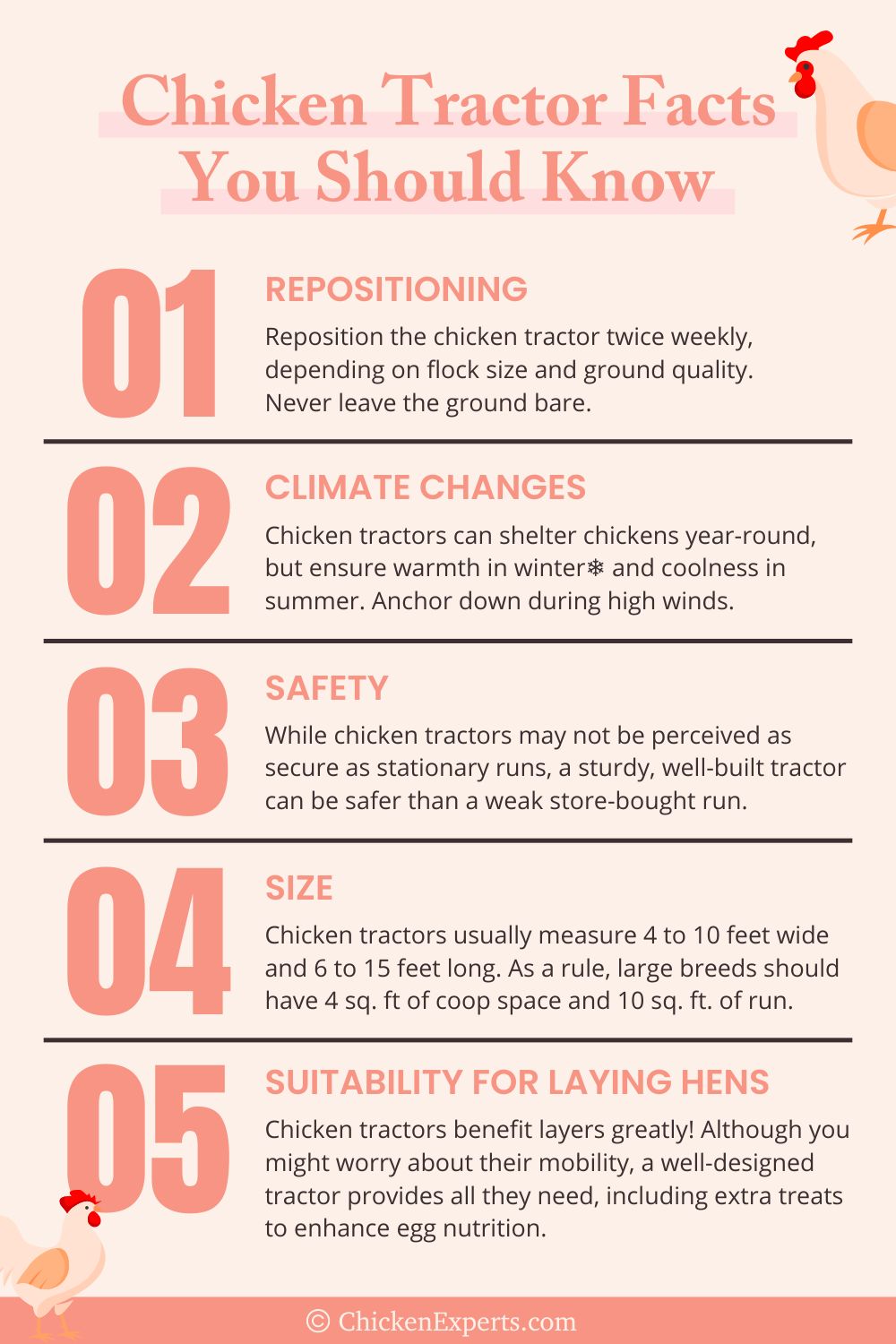
How Tall Should Chicken Tractors Be?
It’s easy to focus on ground space and forget about headroom in chicken tractors. The overall shape and design of your run will impact how much your chickens get to enjoy it.
Some breeds are flightier than others and will benefit from a taller run to stretch their wings in and maybe some high perches. You’ll still need to get in there from time to time, so a taller ceiling will make life more comfortable for you, too.
Which breeds of chicken can fly?
Are Chicken Tractors Suitable for Laying Hens?
Chicken tractors are highly beneficial for your layers! It’s easy to worry that rolling around might not be the lifestyle for a lady who lays, but a well-designed chicken tractor will offer her everything a standard setup does, plus eggs-tra yummies to bulk out those eggs with nutrients.
Chicken keepers who switch from static runs to tractors often spot an increase in their hen's productivity, since they had access to more protein, vitamins, and minerals including vitamin E, vitamin C, and Iron.
You should still supply nest boxes and harvest eggs daily. Never move a chicken tractor when you can hear Momma hen at work. That’s just cruel and it could be messy.
How Do You Move a Chicken Tractor Without the Chickens Escaping?
Seems like a flaw in the plan, doesn’t it? If you lift your tractor even an inch to move it those cheeky chicks are guaranteed to squeeze through the gap. Move your tractor in the evening if you can, or in the morning whilst chickens are in their coop. The evening is best unless you fancy your eggs scrambled.
Are Chicken Tractors Expensive?
Chicken tractors are priced similarly to static runs meaning the price can vary greatly. Standard A-frame tractors tend to be around 300 to 400 dollars.
Who said you need to buy them, though?
Designing your chicken tractor carefully helps you make the most of the space you have to work with. Raising the coop section off the ground within the run creates more floor space, provides shade, and is the perfect place to hang a waterer from. Raised coop sections are also better protected from dampness and drafts.
Are Chicken Tractors Easy to Build?
DIY chicken tractors are perfect for the frugal folk and sustainable Sally’s out there. You needn’t be a builder by trade: chicken tractor designs can be as simple as a lightweight timber A-frame that can be pulled around by hand, or a cluxury fowl-friendly hotel on wheels. Chickens really don’t care if the corners are perfect!
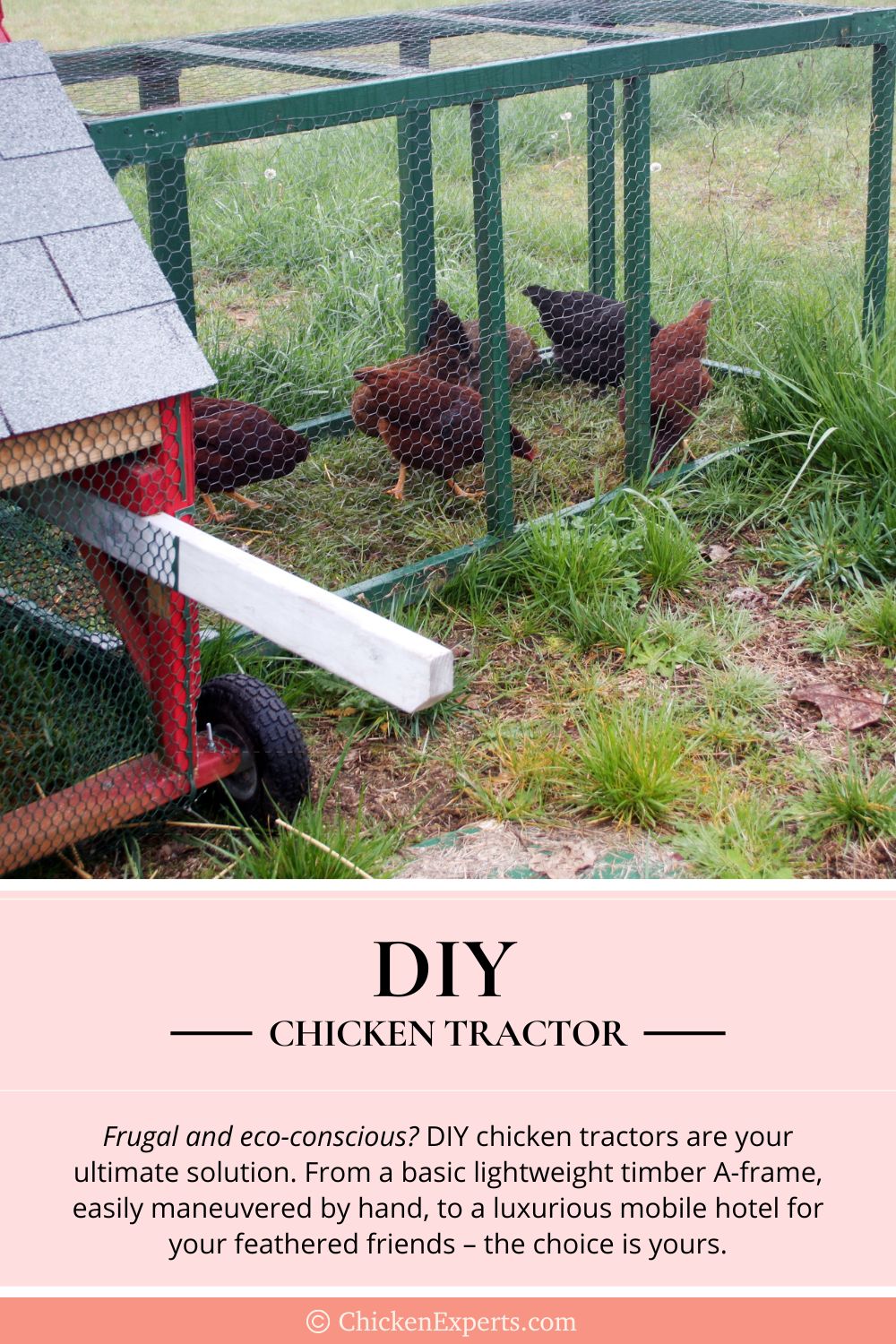
Converting a standard coop to a tractor is also possible, so if you’ve already invested, but your new chickens have destroyed their carpet already, you don’t have to start all over again.
DO YOUR HENS HAVE A TRAILER?
Pop your egg-sperience of mobile hen homes in the comments
Wondering if a chicken tractor is a way to go? If you have the land then a chicken tractor is great for your flock’s health, even if you’re not too fussed about any of the other benefits.
The only reason I would say not to treat your cheeps to some wheels is if you don’t have the dedication or inclination to move it regularly, or if you have a high risk of dig-happy predators in your area.
Already designing your chicken trailer in your mind? Planning your chickens’ accommodation is one of the many fun and functional parts of chicken keeping. Don’t delve in with a design or click buy until you’re certain your chicken’s home will work for them, and you.
You can’t afford to wing chicken real estate. Regardless of whether you buy or build, you need to check this out. You can thank me later.
This beginner-friendly course is split into lessons that cover everything you’ll need to know to buy or build the perfect chicken coop, run, or tractor. There’s even a dedicated buy or build section to help you decide on the best option for you, and a detailed checklist of design considerations.
Happy Hen House hunting!











Leave a comment (all fields required)